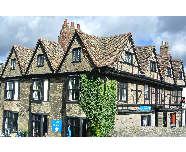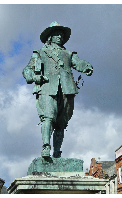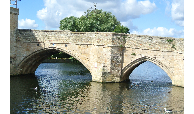
A Brief History
Important dates
Saxon times: Although a Roman villa has been found close to St Ives, the town came into existence in Saxon times then known as Stepe. A natural flint ford river crossing eventually provided the base for the bridge which unusually has a Chapel in the middle. The River Great Ouse provided transport, water and livelihood for the small community
1001 - A local ploughman discovered a stone coffin declared by the landowner, the Abbot of Ramsey Abbey, to be the mortal remains of a Persian missionary Bishop, St Ivo, who had died some 400 years earlier (it was probably a roman burial close to the Roman villa). St Ivo's priory was founded on the site and became a famous attraction for pilgrims which turned the village into a major town.
1086 - In the Doomsday Book St Ives is recorded as having 51 adult male dwellers (women and children weren't counted)
1110 - Henry I awarded the town its first charter and a major annual fair that attracted buyers of clothes manufactured and dyed locally on stretched wooden frames called "Tenterhooks". The bridge with its chapel was rebuilt and the town continued to enjoy great prosperity.
1200 - King John grants the first charter for a market in St Ives opening the way for greater prosperity and the development of St Ives as a market town
1320 - The Priory Barn is built, This is the oldest surviving building in St Ives.
1420 - The famous Bridge and Chapel are completed enhancing St Ives access to the country to the south and London
1590 - The Manor House next to the river is completed. Its the oldest surviving residence in St Ives
Middle Ages - The town remained a great trading centre with many fairs and is almost certainly the St Ives referred to by the famous riddle rhyme
|
|
As I was going to St Ives |
|
|
I met a man with seven wives. |
|
|
Each wife had seven sacks, |
|
|
Each sack had seven cats, |
|
|
Each cat had seven kits; |
|
|
Kits, cats, sacks and wives - |
|
|
How many were going to St Ives? |
and the answer to the riddle? 1, as all the wives, sacks, cats and kits were going the opposite way as the poet met them
1631 - Oliver Cromwell Born in Huntingdon on 25 April 1599 he died of natural causes on 3 September 1658. His statue in the market square is one of only four on public display in England. Cromwell moved to a farmstead in St Ives in 1631 with his wife Elizabeth Bourchier. He had by then become a devout Puritan and member of Parliament for Huntingdon (which included St Ives in its boundaries) followed many years later by John Major. Cromwell blew up two arches of the famous bridge in St Ives to prevent their use by Royalists approaching London from their base in Lincolnshire. The statue was constructed about 1900 and sculpted by F W Pomeroy
18th & 19th Century - St Ives became a major transport hub with coal and cattle coming from the coastal ports and fens for onward transportation to London. in 1888 Herbert Norris, the local historian for whom the local museum is named, wrote "St Ives was formerly the centre of a great river traffic. I have seen the river so covered with barges, that boys could walk across the river near the Quay on their tops".
1847 - The Cambridge to St. Ives railway opened in St Ives on 17 August 1847 and was finally closed on 5 October 1970 after surviving the earlier Beecham's Axe.
2011 - The Cambridge Busway opened on 7 August 2011 after 4 years of construction and huge overspends along the lines of the Railway
Copyright© Huntingdon Commercial Property Corporation Ltd. (HCPC) 2015


